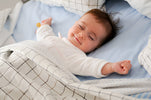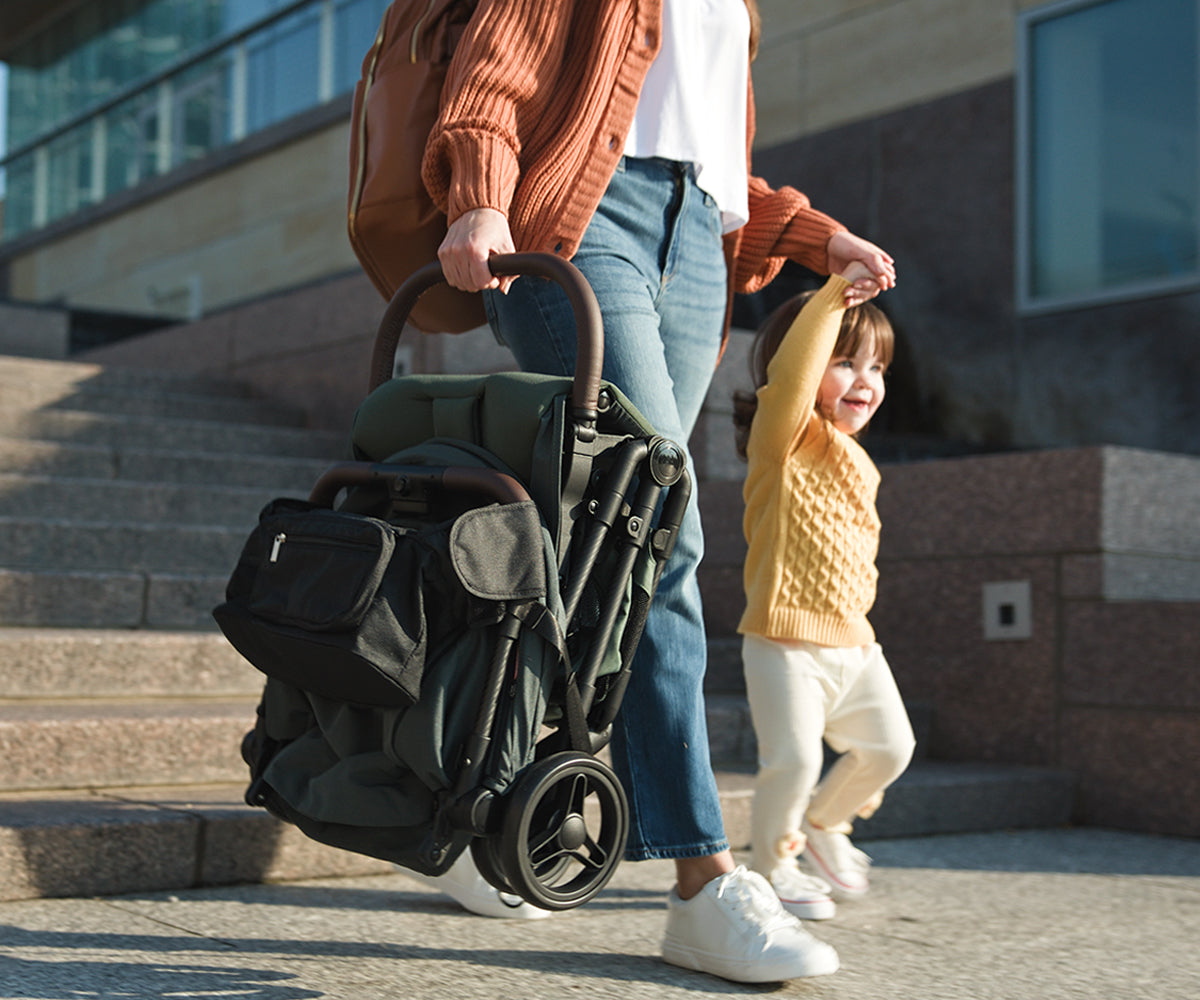
Baby Sleep Training 101: A Guide for New Parents
, by Artorias Tse, 9 min reading time

, by Artorias Tse, 9 min reading time
Sleep training or, simply, establishing a healthy sleep pattern is a mandatory aspect of parenting. It not only helps the baby's overall well-being but also parents' relaxation. Sleep training requires you to create a structured routine to make the little ones learn to self-soothe and sleep for longer stretches.
A supportive sleep environment is the foremost step regarding successful sleep training. Parents can further enhance a baby's sleep experience with nursery chairs (often synonymously used as nursering chairs), soothing rocking chairs, and a baby stroller for naps on the go. The comprehensive article looks into every essential point you should know to accomplish baby sleep training as a parent.
It's the process of teaching a baby to fall asleep independently and sleep through the night. And it should happen with minimal parental intervention. The process involves establishing consistent sleep routines, habits, and techniques to develop healthy sleep patterns.
Encourage independent sleeping to help learn self-soothing and falling asleep without assistance.
Improve sleep duration by reducing frequent night wake-ups and promoting uninterrupted sleep.
Establish a consistent sleep schedule as the little one's sleep aligns with a structured daily routine.
Reduce sleep deprivation by improving parents' well-being with the least sleep disturbances.
Healthy development as sleep ensures adequate rest for cognitive, emotional, and physical growth.

Better Sleep for Baby and Parents – The process focuses on more restful sleep cycles for long hours.
Improved Mood and Behavior – Well-rested babies usually remain happier, engaged, and less fussy.
Healthy Growth and Development – Quality sleep is vital for brain development and immune function.
Enhances Family Well-Being – Parents experience less stress, leading to a healthier family dynamic.
Establishes Long-Term Sleep Habits – It encourages lifelong good sleeping patterns from an early age.
Crib or Bassinet – Choose a crib that complies with all the safety standards (firm mattress, reasonable slats). A bassinet seems ideal for newborns that should transition to a crib by 4 – 6 months.
Dresser with Changing Table – A multi-purpose dresser with a changing station helps save space. Also, use drawer organizers for easy access to essentials like diapers, wipes, and clothes.
Comfortable Rocking Chair or Glider – It can help parents soothe the baby before bedtime to a great extent. Opt for an ergonomic design with armrests for comfortable feeding sessions.
Pushchair / Baby Stroller – You can still ensure sleep consistency during daytime naps outside the home. Get one with reclining seats and proper ventilation to create a supportive napping space.
Storage Bins and Shelves – Always keep items like diapers, wipes, pacifiers, and sleepwear organized. Put some open baskets around to access bedtime and playful items easily.
Blackout Curtains – Blocking the outside light is obligatory for better naps during the day and even nighttime sleep. But choose thermal-lined curtains to keep the room temperature controlled.

White Noise Machine – It mimics womb sounds and blocks household noise. Install one with an adjustable volume and automated shutoff timer.
Nightlight with Soft Glow – It helps with nighttime feedings and diaper changes. Choose warm, dimmable light (amber or red tones are best for sleep).
Humidifier/Air Purifier – Keeping the air moist can prevent congestion and dry skin. Go for cool mist humidifiers, as they are somewhat safer for babies.
Baby Monitor – It ensures peace of mind by allowing parents to check on the baby remotely. Choose a model with video and audio for better monitoring.
Follow a bedtime routine and put the baby down, drowsy but awake. Leave the room and don't return unless necessary (feeding or changing). The baby learns to fall asleep independently over time.
This one often works quickly (within a few days) and helps the baby sleep longer at night. But leaving like that feels bothersome for many parents. And it may not be suitable for highly sensitive babies.
Place the baby in the crib, drowsy but awake. Set a set time before checking in for crying babies. Offer comfort briefly without picking them up. Try to increase the waiting period each night (when possible).
This highly preferred method feels less stressful and concerning. And it even encourages self-soothing over time. However, the time requirement is quite long and needs consistency for weeks and months.
It is concerned with gradually reducing presence until the baby learns to sleep independently. Put a chair beside the crib to sit nearby as the baby falls asleep. Move it farther away until you are out of the room.
This one provides some emotional security. And it works well for parents who are uncomfortable with the CIO. Likewise, it takes longer to see results that will definitely test your patience and commitment.
It helps babies fall asleep without altogether leaving them alone. Pick up the crying baby and comfort him/her. Put them back down before they fall asleep. Repeat the steps until they sleep independently.
The gentle and supportive method encourages self-soothing to a great extent. But the time-consuming process requires patience. The continuous repetition is likely to overstimulate extra-sensitive babies.

Preparing for Travel – Try to keep up your sleeping schedule at home before traveling. Before the trip, avoid introducing new sleep associations (rocking or feeding to sleep).
Plan Travel Around Nap and Bedtime – Schedule your flights or car rides during naps (whenever possible). Try to arrive at the destination before bedtime for adjustments.
Pack Familiar Sleep Essentials – Babies sleep better when surrounded by familiar comfort items. Use a portable white noise machine, blanket, sleep sack, or stuffed toy.
Maintaining Sleep Training – Use a suitable baby carrier (travel stroller) for comfort. Mimic bedtime cues with dimmed lights, pacifier assistance, and/or play white noise.
Traveling by Car – Schedule long drives around the usual routine. Block sunlight while playing lullabies or white noise apps. Also, take breaks for movements to reduce discomfort.
Crying is a normal response to change. Babies may resist falling asleep independently. Some sleep training methods (Ferber or CIO) may involve temporary crying.
Choose a sleep training method that suits your baby's overall temperament. Use timely check-ins to offer comfort without picking up the baby (soft voice, gentle patting).
It indicates that your baby hasn't learned to self-soothe yet. The wake-ups can result from regressions (4-month sleep regression), hunger/discomfort (teething, gas, wet diaper), and overtiredness.
Encourage self-soothing by putting the baby down, sleepy yet awake. Rule out physical discomfort (check for teething, gas, or a wet diaper). Stick to a fixed bedtime and wake-up time to regulate body clocks.

The little ones suffer from short sleep cycles (30 – 45 minutes) without transitioning between cycles. Either your baby is overtired or not tired enough at nap time, deriving from external distractions.
Follow an age-appropriate wake window (too much or too little wake time). Ensure a dark, quiet, calm sleep environment for deeper sleep. Try resettling after early wake-ups (patting and shushing).
This one is common at 4, 6, 8, and 12 months due to brain development. Babies practicing skills (rolling, crawling, standing, talking) while asleep also experience it. Growth spurts and teething cause discomfort.
Stick to the usual sleep routine. Also, it offers extra comfort without forming lousy sleep habits (rocking to sleep). Adjust wake windows and maintain a calm environment with dim lights and/or quiet sounds.
It happens because the baby has developed sleep associations (rocking, feeding, or pacifier). They heavily rely on parents to fall asleep instead of self-soothing.
Employ the 'fading method' by gradually reducing rocking/feeding each night. Introduce a transitional object and replace feeding-to-sleep with a bedtime story/lullaby.
What is the difference between a nursery chair and a rocking chair?
Answer: A nursing chair provides stationary comfort, while a rocking chair adds gentle movement.
How can a stroller or baby stroller help maintain sleep routines on the go?
Answer: A reclining stroller with a comfortable headrest can be a portable sleeping environment.
You should understand by now that successful baby sleep training depends on a sleep-friendly environment. You can achieve such a surrounding with key elements like a nursery chair, rocking chair, and baby stroller.
Consistent routines establish healthy sleep habits as you stick to an effective training method tailored to your needs. As a parent, don't back down from trying different sleep training techniques. The same goes for nursery setups as you invest in comfy furniture.

YOUR FIRST ORDER